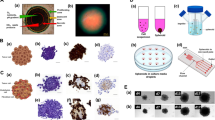Abstract
With the aim to utilize human mesenchymal stem cells (hMSCs) grown in large scale for regenerative medicine, effects of agitation rate on aggregation during beads-to-beads subcultivation of microcarrier culture of hMSCs were studied. hMSCs could attach and grew on surface-type microcarriers of Cytodex 1, whereas almost no cell elongation and growth were observed on porous type microcarriers of Cytopores. The percentages of aggregated Cytodex 1 microcarriers at an agitation rate of 60 and 90 rpm were lower than that at 30 rpm, which was the lowest agitation rate necessary for the suspension of Cytodex 1 microcarriers, and the cells grew fastest at 60 rpm. hMSC could be subcultivated on Cytodex 1 by the beads-to-beads method at both 30 and 60 rpm without trypsinization. However, agitation at 60 rpm resulted in a markedly lower percentage of aggregated microcarriers not only before but also after subcultivation. The percentages of CD90- and CD166-positive cells among cells grown on Cytodex 1 at 60 rpm (91.5 and 87.6 %) were comparable to those of cells grown in the pre-culture on dishes. In conclusion, hMSCs could be subcultivated on Cytodex 1 by beads-to-beads method maintaining the expressions of the cell surface antigens CD90 and CD166, while adjusting agitation rate could decrease the microcarrier aggregation.





Similar content being viewed by others
References
Borys MC, Papoutsakis ET (1992) Formation of bridges and large cellular clumps in CHO-cell microcarrier cultures: effects of agitation, dimethyl sulfoxide and calf serum. Cytotechnology 8:237–248
Chua S, Yuen CM, Leu S, Lin YC, Sun CK, Yip HK (2010) Adipose-derived mesenchymal stem cells markedly attenuate brain infarct size and improve neurological function in rats. Eur Heart J 31:80
Ferrari C, Balandras F, Guedon E, Olmos E, Chevalot I (2012) Limiting cell aggregation during mesenchymal stem cell expansion on microcarriers. Biotechnol Prog 28:780–787
Frauenschuh S, Reichmann E, Ibold Y, Goetz PM, Sittinger M, Ringe J (2007) A microcarrier-based cultivation system for expansion of primary mesenchymal stem cells. Biotechnol Prog 23:187–193
Malda J, Van Blitterswijk CA, Grojec M, Martens DE, Tramper J, Riesle J (2003) Expansion of bovine chondrocytes on microcarriers enhances redifferentiation. Tissue Eng 9:939–948
Nienow AW (2006) Reactor engineering in large scale animal cell culture. Cytotechnology 50:9–33
Sanford KK, Earle WR, Evans VJ, Waltz HK, Shannon JE (1950) The measurement of proliferation in tissue cultures by enumeration of cell nuclei. Anat Rec 106:243
Sato Y, Wakitani S, Takagi M (2013) Xeno-free and shrinkage-free preparation of scaffold-free cartilage-like disc-shaped cell sheet using human bone marrow mesenchymal stem cells. J Biosci Bioeng 116:734–739
Schop D, Janssen FW, de Bruijn JD, Van Dijkhuizen-Radersma R (2008) Expansion of mesenchymal stem cells using a microcarrier-based cultivation system: growth and metabolism. J Tissue Eng Regen Med 2:126–135
Shiragami N, Honda H, Unno H (1993) Anchorage-dependent animal cell culture by using a porous microcarrier. Bioprocess Eng 8:295–299
Takagi M, Okumura H, Okada T, Kobayashi N, Kiyota T, Ueda K (1994) An oxygen supply strategy for the large-scale production of tissue plasminogen activator by microcarrier cell culture. J Ferment Bioeng 77:301–306
Takagi M, Sasaki T, Yoshida T (1999) Spatial development of the cultivation of a bone marrow stromal cell line in porous carriers. Cytotechnology 31:225–231
Wang Y, Ouyang F (1999) Bead-to-bead transfer of Vero cells in microcarrier culture. Cytotechnology 31:221–224
Yamahara K, Taguchi A, Soma T, Ogawa H, Ikeda T, Yoshimatsu J (2014) Clinical application of human amnion-derived mesenchymal stem cells for the treatment of acute GVHD. Placenta 35:A6
Author information
Authors and Affiliations
Corresponding author
Rights and permissions
About this article
Cite this article
Takahashi, I., Sato, K., Mera, H. et al. Effects of agitation rate on aggregation during beads-to-beads subcultivation of microcarrier culture of human mesenchymal stem cells. Cytotechnology 69, 503–509 (2017). https://doi.org/10.1007/s10616-016-9999-5
Received:
Accepted:
Published:
Issue Date:
DOI: https://doi.org/10.1007/s10616-016-9999-5




